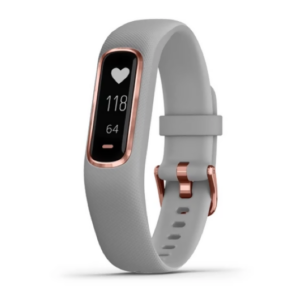
Heart Rate
The mEMA System is deeply integrated with Garmin wearable devices. We use the Garmin Companion SDK to pull real-time data directly from the wearable into the mEMA app. From there it can be sent up to the ilumivu server in combination with the mobile EMA data and used to trigger events on the phone.
This article provides a description of the Heart Rate data the mEMA app receives from the Garmin Vivíosmart 4 in real-time and highlights the published research available on accuracy.
The SDK allows the continuous monitoring of instantaneous Heart Rate (HR). This is simply the average speed of the most recent few heart beats in beats per minute.
It is calculated as number_of_beats*60 / observation time.
So if the device detects 4 beats in the last 3 minutes then your current HR is 80 (4*60/3 = 80).
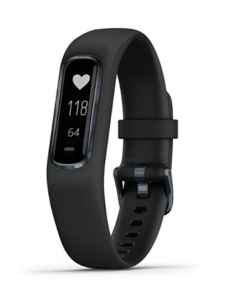
The Heart Rate data from the Garmin Vivíosmart 4 look like this is their raw form once uploaded to the ilumivu server.
Column A: Date /time
Column B: Unix timestamp
Column C: data label
Column D: value – in this case instantaneous heart rate
Note: The Garmin devices also allow us to collect raw Inter-Beat-Interval (IBI) data from which we can calculate HRV.
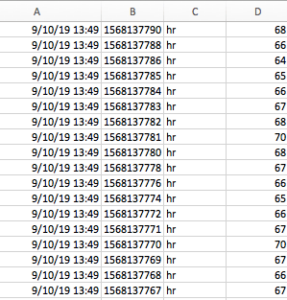
Relevant Research
A small body of published research has begun to investigate the accuracy of the Garmin Smartwatches against gold standard ECG monitors.
A 2018 paper in the Journal of Diabetes Science and Technology compared Fitbit and Garmin consumer grade devices with three research grade devices to look at Energy Expenditure (EE) and Heart Rate (HR). They concluded that both devices operated within a ~10% error margin during a range of difference physical activities and that this is clinically acceptable for research use.
A 2018 study in the Canadian Journal of Cardiology compared a variety of fitness trackers against standard ECG in patients from an outpatient cardiology clinic in their 50s and 60s. Their results are shown in the table below.
AF = Atrial fibrillation; SR = Sinus Rhythm
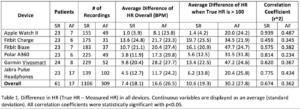
When HR was below 100bpm and patients were in sinus rhythm (part of the normal range of cardiovascular functioning) the Apple Watch was only 1.0 beat off the true HR, the Polar A360 3.8 beats off and the Garmin Vivíosmart 9.8 beats off. Both Fitbit devices we over 10 beats off. All the devices were less accurate when the patients was in AF and when true HR was over 100 bmp.
In a 2018 conference paper 4 healthy participants rotated wearing 4 different Vivíosmart 3 devices as they walked at various speeds on a treadmill. The data collected were compared to a baseline ECG device and Mean Absolute Percentage Error (MAPE) and IntraClass Correlations (ICC) were calculated. A MAPE of 10% of above was considered unacceptable. Their results showed that each individual device performed differently across different participants.
The table and figure below show the differences across individuals with different devices (red, blue, green and black).

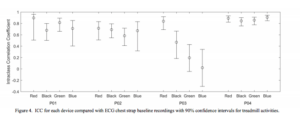
The devices that show an acceptable level of accuracy for Participants 1 and 4 shows MAPEs over 10% for Participants 2 and 3. The authors suggest this may be due to the greater age of P2 (54 yrs) and P3 (47 yrs) compared to P1 (25 yrs) and P4 (28 yrs). In P1 and P2 the Garmin Vivíomart 3 showed ICC with the ECG of between 0.68 and 0.90 and in P3 and P4 between 0.02 and 0.91.
Finally, a 2019 publication in the journal Cardiovascular Diagnosis & Therapy compared various fitness monitors to a three lead ECG with athletes running at various speeds from 4mph to 9mph on a treadmill. The Garmin Viviosmart HR, the Fitbit Iconic and the Tom Tom Spark 3 all showed the same level of agreement with the ECG with a Lin’s concordance correlation coefficient rc r=89. The Apple Watch showed a high level of agreement at rc r=96 and the Polar H7 chest strap the highest at rc r=98.
